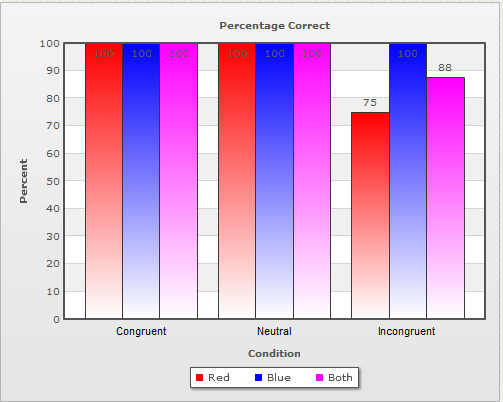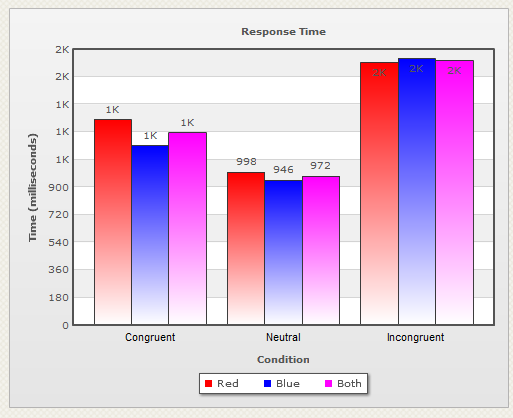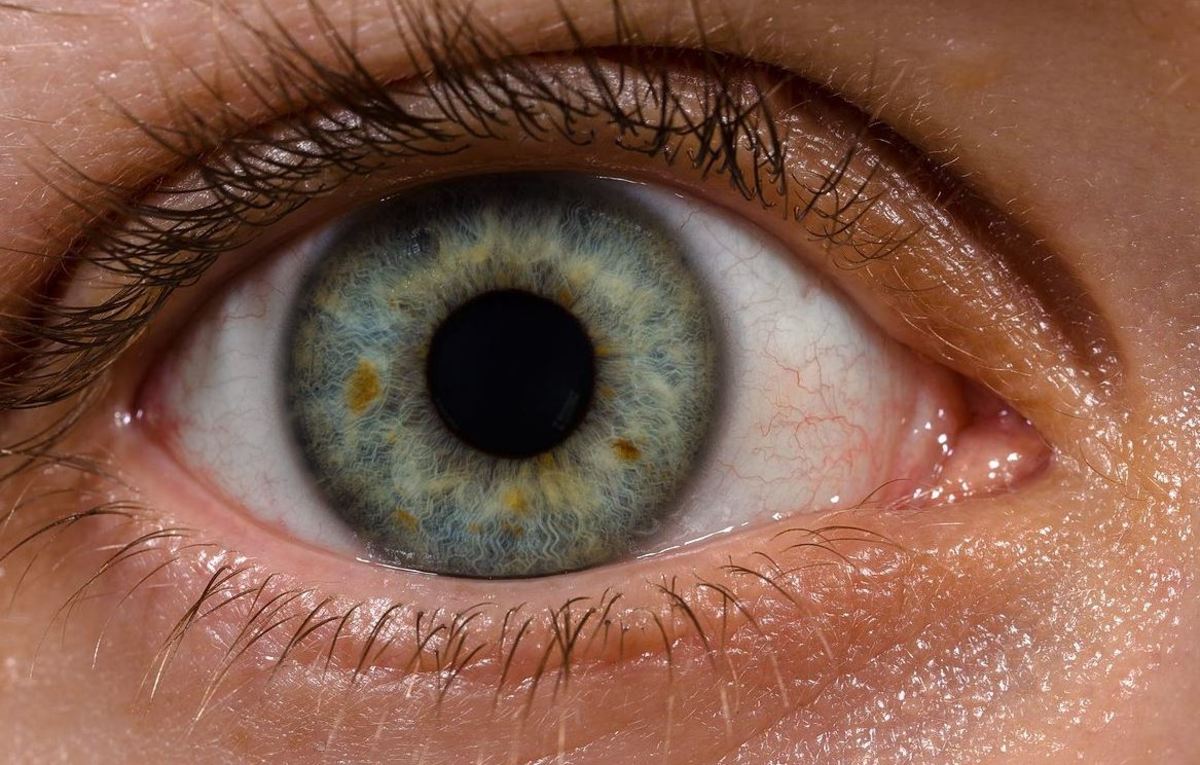Cognition, Emotion, Attention
If you have ever tried to type a text message or email on someone else’s phone, you probably found it a little frustrating, especially if their keyboard layout is very different than yours. You probably typed more slowly or made more errors than you normally do when typing on your phone. The reason typing on a different keyboard is difficult is because an “automatic” process (the finger movements you make on your phone) is interfering with an “intentional” process (the finger movements you must make on your friend’s phone).
John Ridley Stroop was interested in studying the interference produced by another automatic process -- reading. It was well known at the time Stroop conducted his research that people read words faster than they could name colors (Cattell, 1886). Stroop combined words and colors to create an interference effect. Specifically, Stroop presented color words in incongruent ink (e.g., RED). He was interested in how the ink color influenced reading the words and how the words influenced naming the ink colors. Stroop’s experiments represented his dissertation work and were published in a now classic article (Stroop, 1935).
In one condition of his experiment, Stroop had subjects name the ink color, while ignoring the actual word. For example, if the item was "BLUE" the correct response would be "red." Subjects found this task significantly more difficult than naming colors that were shown in a block form instead of a word form. The automatic process of reading the word "blue" interfered with the intended process of naming the color. This interference is now known as the "Stroop Effect." The experiment you are about to participate in allows you to experience this effect for yourself.
You will be completing the Stroop experiment.
In this experiment, you will be shown a series of color words (red, blue) or a non-word (OOOO). These items will be in either a red or blue font color. Your task is to identify the color of the font as quickly as possible while ignoring any words or Os. Indicate your response by pressing the left arrow on the keyboard for Red, and the right arrow for Blue.
You will first experience 6 practice trials during which only OOOO’s will be shown. In the actual experiment both OOOO’s and words will be shown, but remember you are always to name the color of ink, not the word.
Things to keep in mind for a Stroop Experiment:
- Your index fingers should remain on the left and right arrow keys to enable rapid response.
- Press the left arrow on the keyboard for Red, and the right arrow for Blue.
- Expect to make a few mistakes because of going fast. That's OK.
- Minimize distractions and stay focused for the length of the demonstration.

My Results Percent Correct
Now that you have completed the experiment, let’s take a look at your results. We recorded your accuracy and your response time under three different conditions: 1) In the congruent condition, the ink color matched the word (RED or BLUE). 2) In the neutral condition only OOOO’s were shown. 3) In the incongruent condition the ink color did not match the word (RED or BLUE).
Look at the graph to the left, which shows your percentage correct on each of the three conditions. If reading the words interfered with your ability to name the color, you should see one or both of the following outcomes. First, your accuracy may be worse (lower bars) for the incongruent condition than the other two conditions. This would happen if you responded with the word itself rather than the color of the word.

My Results Response Time
Now, let’s look at the graph showing your response time. Your response time may be slower (higher bars) for the incongruent condition than the other conditions. This will happen because of the delay caused by automatically reading the word instead of just thinking about the color.
Remember:
- In the congruent condition, the ink color matched the word (RED or BLUE).
- In the neutral condition only OOOO’s were shown.
- In the incongruent condition the ink color did not match the word (RED or BLUE).
What pattern of results did you get for your data?
Both my accuracy and response time data show the Stroop effect.

MacLeod (1992) has called the Stroop task the “gold standard” of attention tasks. Variations of the task exist. For instance, Rosinski, Golinkoff, and Kukish (1975) created compound stimuli in which a word appeared inside a picture. Similar to Stroop, they found interference when the words and pictures were incongruent. Thus, over time, tasks in which two related but incongruent components are combined to form a compound stimulus are often referred to as Stroop tasks.
The Stroop effect is not limited to visual modality. Hamers and Lambert (1975) presented the words low and high in either a low (110 Hz) or high (175 Hz) pitch. Participants were slower responding to the pitch when the incongruent word was presented (i.e., the word low in a high pitch).
The Stroop effect does have some interesting applications. Given that the effect is caused by an automatic process – reading – it can be, and purportedly was used to catch Russian spies (Baumeister & Tierney, 2011). A person who does not read Russian will not experience any interference when trying to name the colors in the bottom set of words. However, if you claim that you don’t read Russian but are slowed down when naming the colors of those incongruent Russian words, you may want to rethink your story. The fact that the incongruent Russian words slowed you down when trying to name the font color is a clear indication that you can in fact read Russian.
References
Baumeister, R., & Tierney, J. (2011) Willpower: Rediscovering the Greatest Human Strength. New York: Penguin Press.
Cattell, J. M. (1886). The time it takes to see and name objects. Mind, 11, 63-65.
Harners, J. F., & Lambert, W.E. (1972). Bilingual interdependencies in auditory perception. Journal of Verbal Learning and Verbal Behavior, 11, 303-310.
MacLeod, C.M. (1992). The Stroop task: The “gold standard” of attentional measures. Journal of Experimental Psychology: General, 121, 12-14.
Rosinski, R. R., Golinkoff, R. M., & Kukish, K. S. (1975). Automatic semantic processing in a picture-word interference task. Child Development, 46, 247-252.
Stroop, J. R. (1935). Studies of interference in serial verbal reactions. Journal of Experimental Psychology, 18, 643-662.
How do your experiment results relate to what you have learned in this module? What insights did you gain about cognitive processes and associated research methods by participating in this experiment?
I scored 100% correct on the congruent and the neutral stimulus. On the incongruent stimulus I scored 75% correct on the red, 100% on the blue, and 88% on both. My response time for the congruent was in the 1 K range, for the neutral my time was between 946-998 milliseconds, and for the incongruent my time was in the 2 K range. My results show that I experienced the Stroop effect; my percent of accuracy fell when the font color did not match the word and my response time increased. My accuracy was higher both when the word matched the color and when only OOOO’s were shown likewise my response time was faster. I believe that my response time was the fastest on the OOOO’s because I did not have to take the extra time to separate the color from the word.
In relation to this week’s module I found that the level of Stroop effect was affected by my skill in reading; “poor readers tend to show larger Stroop effect than good readers, perhaps because better reader have greater executive control over their attentional resources” (Ashcraft & Radvansky, 2014, p. 128). I believe that this is true because during my stroop experiment I did experience a small Stroop effect and I am a good reader. I believe the Stroop experiment might at some point be able to be used with young children to test their reading skills without them being aware that they are being tested. I feel that the Stroop effect could at some point give insight into children’s cognitive processes in relation to their reading level.
References
Pearson. (2014) Stroop. Retrieved From: http://pet.pearsoncmg.com/dashboard
Radvansky, G. A., & Ashcraft, M. H. (2014). Cognition Sixth Edition. Upper Saddle River: Pearson.
The relationship between cultures and social cognition: Kaiping Peng
The relationship between cultures and social cognition: Kaiping Peng
"1. How did you become interested in psychology?
>> I because historical contingency. Because I'm from China. Psychology was banned by Chinese government for 30 years after 1949. So in 1979 that was the year I applied to college, and I was actually majored in physics. I had no interest in psychology. As a matter of fact, I didn't know anything about psychology. Interestingly enough, that was the year that China had normalized its relation with the United States. The first US delegation who visit China was a scientist [inaudible] of a scientist. The leading -- the leading -- I think the leader of the group was Richard Atkinson , who happened to be a psychologist. So the Chinese [inaudible] was [inaudible] about that, his mission like why is psychology to be the leader of the science group. Then he tell those people psychology is a science, and that's the time the Chinese government decided to have psychology. But they had no student, no faculty. They just run [inaudible] people from different departments, and I was one chosen. I didn't want to go to psychology, but they call my father, and my father said, you know, you should study psychology because our country needs you to study psychology. He started the contingency, interesting.
2. What is your current area of research?
>> When I was in China, my specialty was in clinical psychology. I was trained as a Clinical Psychologist. My focus was very much on management and testing. Probably in 1989 I came to United States, and -- and wanted to, you know, spend my sabbatical year at Michigan. And that was the time that the Tiananmen Massacre happened. And I was very much against it, and so the Chinese government kicked me out of the university. So I basically lost my job at the Beijing University, and -- but I couldn't teach in the United States because I didn't have an American education. No American university would accept my degree from Chinese university. So I decided to pursue psychology again at Michigan. And it's very hard for me to get into clinical psychology because my English was very bad. I didn't -- I -- there was no need for me to learn English anyway at that time. So I decided to study another field -- happened to be -- the case is that the Michigan at that time had the first training [inaudible] on cultural psychology for NSF. So they award me the fellowship, so I was the first recipient of the NSF cultural psychology graduate training fellowship. And I start my career as a cultural social psychologist. And that's been almost 10 years now, hey more than 10 years.
3. Can you talk about your interests in cultural psychology?
>> Yeah, my major focus was actually in the cultural psychology -- basically studying how cultural experience, cultural identity, cultural values affects individuals' psychological process, particularly the reasoning, judgment, and decision making. Recently I started to study how culture affects moral judgment, because I think much of the cultural conflicts and misunderstandings, you may be surprised is not about performance differences, about economical differences. It's really about the moral conflict -- the identity conflicts. We ask people simple questions, like how many people you think are smarter than you? They can accept 70% of people -- 40% of people smarter than they are. They can also accept that probably people are good looking than they are. But nobody would accept that people have higher moral standard than they are. So moral -- moral standards is a core at the individual identity and the cultural identity. Just look at the international conflicts these days. You'll be surpriseid that most of them is about who's better, who's right, who's wrong. So that's why I get into moral judgment issue, particularly how moral information affects people's understanding about causal events.
4. Discuss the research you have been conducting.
>> Well I've been experimental social psychologist, so most of the time I study, you know, been doing researching laboratory. For more information we try to manipulate information that people can see. So we randomly assign people into different groups so they gather different informations. Sometimes the information is about the morality of the [inaudible] persons, sometimes the information is about, you know, intelligence of the person, sometimes it's about the other identities. And we -- then we look at how people response to those different informations, and how they use those informations to make a judgment about other person. So laboratory experimental study, those are my focus.
>> Okay, great.
5. What types of tasks do you ask participants to perform during your experiments? What results have you seen?
>> Well we have a -- the one -- we had given people like free sample, we gave people a story about the person who was speeding and trying to get home. And -- but by talking about the stories, we give people a little bit more information. For instance, in one situation the person who -- who's speeding was a drug dealer, so basically has no moral standard. In other information -- in other conditions the information we gave to subjects was about a person as an elementary school teacher. He was speeding home because he wanted to hide the present he -- he purchased for his wife. So he wanted to give his wife a surprise, so that's high moral situation. And simply because we gave this little bit of information about the morality of the person, then we got the people have a totally different judgment about the causes of these incidents, like speeding. So for no moral people, people would think that, you know, he did it because he was a bad person, so he had a habit of speeding and he will kill people, regardless the consequences. [inaudible] the high moral people more likely became benefits of doubt. And by the way, this paradigm [phonetic] has been used by other scholars before [inaudible] who used this paradigm he called that culpable causality. So he has the theory. What he hasn't done and what we are doing is to test that cross-culturally to look at how people from different cultures use this kind of information. What we find is that other cultures actually have more moralistic orientation in the judgment. So the effects is much bigger for people from connective [phonetic] societies like China, Japan, and Korea. And in -- in the United States, middle class, White American kids or college students actually don't want to use moral judgments. If you tell them there's more information there, they will use it. But if you don't tell them, they will use it. So there's obviously some kind of middle class American cultural [inaudible] conflicts going on.
6. Does research tend to confirm or discredit cultural stereotypes? How can you prevent this type of bias when designing studies and analyzing results?
>> Yes, that's another interesting [inaudible] I'm taking. For quite some times we have these stereotypes about Asians to be not creative, they're good students because they remember things, and that they learn things very hard ways, therefore they don't have these creativities. We find that this stereotype is not always accurate. Sometimes it is accurate if you give people typical American task, like [inaudible] that you got Asians don't necessarily like this divergent thinking. However, if you give Asian subjects the Asian-specific task, for instance give an examples, and ask them to come up another ways to describe these examples [inaudible] can do better. We don't call that divergent thinking because we are looking in the United States -- in the Western cultures we're looking for something that is unique, that is different, that's special, even extraordinary, that's what we are looking for. Asians, they have the notion of [inaudible] -- functionality is very important. So if you give an example that is functional and meaningful, they will find another way that is also functional and meaningful. They can do it, and actually they can do better than us -- than subjects in the United States. So what I'm saying is that use this general standardized Western instruments to measure creativities is actually not appropriate. You have to find culture-specific creativity tasks in order to find true culture differences, or similarities.
7. Do certain cultures emphasize differences among individuals more than other cultures?
>> We actually in the United States have cultures that is feared -- I call the [inaudible] of fear of activities. We want to see we all different. We don't want to see [inaudible]. I mean the ideology is about the similarities and equalities, but fundamentally we want to be unique. And that's what the professor, you know, [inaudible] all of them talk about it, is this individualism. Individualism drives us to be unique, to be different. So we value the differences. Versus in other cultures they do emphasize similarities. They value commonality among individuals. So they don't have this fear of being member of the connectivities. So sometimes the consequences is that to people doing cultural psychology -- people in the United States hate when you talk about a cultural differences, because they think we put all the American in the categories. And my middle class American students actually walk away from my class because they -- you're still typing White, you're still typing Asian, you're still typing Black, because you [inaudible] all Asian, White, and Black. We want to be different. That's in the Western cultures. And when I gave similar talks to the Asian subjects and the students, they all say yeah, that's true. That's -- that's Asian, that's us. And that's Americans. I'm not want to -- I don't want to give a value judgment and who's right and who's wrong. But what I want to say is that there are similarities within cultural groups. We don't want to admit that, but the similar socioeconomic experience really make us -- and also similar social [inaudible], similar ideologies really make us similarly in one culture that are different from people in other cultures. We should accept this new reality and study why that's the case, and then we can find the ways to overcome the differences.
8. Explain attribution and the ways we look at people of different cultures?
>> Yeah. Actually the first study [inaudible] study I did was on [inaudible]. It was by a colleague, Michael Morrison [phonetic] at Columbia University. At that time we look at a -- a very famous psychological phenomenon called the fundamental attribution arrow [phonetic]. That phenomenon describe a tendency in the United States that whenever we see a person give something, we tend to attribute the causes of the actions to the individuals. So either that person's personalities or the person's dispositions, or any internal reasons. And we overlook the contextual effects. So we see a teacher give a wonderful talk, we tend to say the teacher is a great teacher, because she was born to be a good teacher. We forgot that maybe the person practice a lot, and trained himself a lot, and maybe is just good a performer. We overlook those kind of tendencies. So that phenomenon has been called from the mental attribution arrow because it's so pervasive, or so common in the Western sample, in the Western studies. We tested in Asian cultures. We find out that the Asian subjects actually less likely make the fundamental attribution arrow. They tend to look at the context effects, tend to find the situational causes, the human actions. So that's the study we did. And many other studies pretty much replicated or confirmed our initial findings. Nowadays we want to see why that's the case. So there are different explanations, and one explanation is a current [inaudible] explanation. It's about the individual [inaudible]. Because we are individualistic cultures. So we want to say individual actions decide -- determine his behaviors or her behaviors. There's people in other societies, particularly collective societies, the social norms -- social expectations is so strong, maybe the action was caused by the social norms. So those people, sensitive to the social expectations, because they are [inaudible]. That's true to a certain degree. But we look at the -- at the [inaudible] social situations, like physical moments, there's no social expectations about why this ball [phonetic] should move in a certain way. But we still find the culture differences that our Western subjects try to look at dispositions of physical objects like shape, size, color to explain the movements. Asians tend to look at the force in the field, the contextual reasons, and dynamic, hydrodynamic, all the medians to explain the movements. So that tendency is deeper than what we call the individual connectivism [phonetic]. So what we want to look at is maybe is a way people use differently informations. Here we tend to focus on the objects. We tend to utilize the information about the objects, whereas people in other cultures have had this to pay attention to the context, therefore they have more information about context. The [inaudible] is trying to argue that perhaps is not just a social value, that it did indicate individuals who [inaudible] sometimes is the cognitive strategies, like what kind of information you like to use that leads to those culture differences.
9. What has surprised you the most in your research?
>> The truth is surprised me the most what is how deep is the cultural differences in thinking and reasoning. Because, you know, for quite some time we think culture is just superficial differences. You know, Chinese use chopsticks and Americans don't. What's the big deal? Fundamentally we're the same. We all have the same mind, we all have the same heart, we feel and think, shouldn't be different. What we find is that those superficial differences actually isn't superficial. They're easy to understand. The deeper differences is deeper than I expected, not just in perceptions. I think, you know, two days ago Professor Richard Nisbett [phonetic] gave a talk on points of view. I actually find that when you give people pictures, that the Western subjects locate the focal objects in the middle, and will spend lots of times just scanning the pictures in the middle. Whereas Asian subjects actually look at the image on the backgrounds. So it's not just, you know, superficial one, it's a fundamental perceptual differences there. Recently the Bureau Of Science study suggests that, you know, that differences is actually reflected at the neurochemical levels. So it's deeper than I thought. That's kind of a surprising. And also the upset of great [inaudible] is also [inaudible]. There is a -- I also find incredible similarities in the fundamental social behaviors. For instance, what kind of a person you like, what kind of person you want to marry, what things you find distasteful, what kind of things you find is tasteful. We usually saw that that's so different, that people have different tastes. But actually if you look at the deep -- at the people's preferences, or desires, you find that lots of similarities. So what [inaudible] that I was surprised by how deep -- cognitive deep are those culture differences. In the meantime, I also surprised how fundamental similarities with human shares [phonetic] our other domains [phonetic] like emotions, like feelings, like desires.
10. What direction do you see your research heading?
>> I want to study the apply side of cultural differences because the, you know, laboratory study demonstrate and show those differences. The question is that what's big deal in the real life and how that affect international politics. How that affects the legal discourse. How that affects people's responsibility judgments because we say causal attribution. We don't just do causal attribution for the sake of causal attribution. We do causal attribution because we want to find out who's responsible for what. So that's the, for the mental social questions we have. So I want to look at how this differences, the psychological differences affects real life cultural interactions, cultural understandings. International politics is like this. You know, there's wonderful [inaudible] concept in political science. It is called deterrence. They talk a lot about deterrence, but they don't study the psychological foundation of that. What is a deterrence? Deterrence is a psychological concept. I scare you so you don't do things, but if I don't know you heart, you minds, then whatever I do won't scare you. The, the deterrence doesn't make any sense. So [inaudible] help people, and the study and understand other people's psychology can help people. Give me one more example, you know, and [inaudible] in United States governments spend millions, millions dollar to produce wonderful drugs to help people, but what if the person will take the drug, take the pill is a psychological question. So I think if we don't study the psychological questions, whatever you done won't have any affects to human life. That's why I want to study, you know, in human actions in every day life what are the psychological mechanisms that are how people, that or force people to do [inaudible] and how the knowledge we get from cross-culture study can help us understand ourself and understand people in other places." (Peng, 2013)








